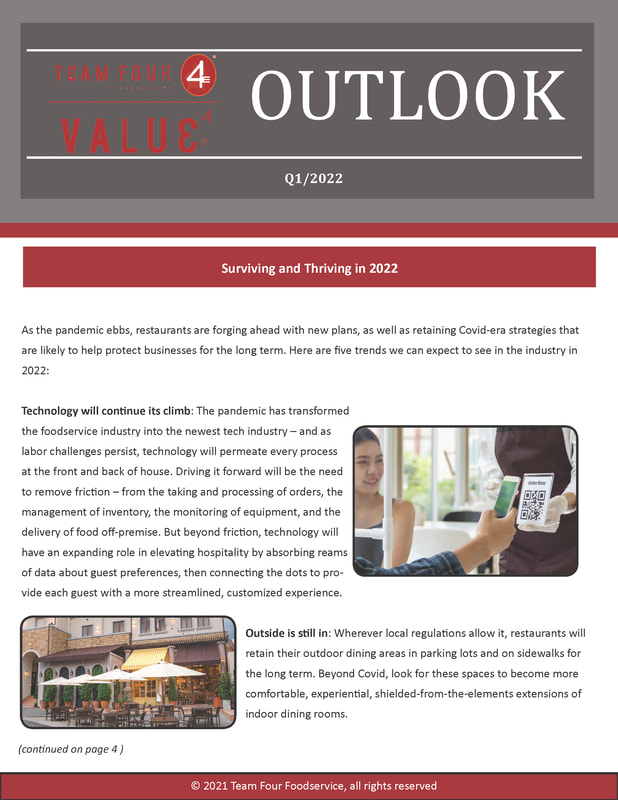 Over the years, how much happy hour business (or other after-work business) has your restaurant generated? If this part of the day once provided a steady stream of traffic for you on several evenings a week, chances are times have changed -- due to factors such as the increase in hybrid work schedules post-pandemic, people’s desire to keep their professional and personal lives separate, and a decline in alcohol consumption. Research from Fox Business found that happy hour traffic has dropped by 49 percent in recent years. If this has impacted your business in any way, it could be a good time to gather your team and identify some new potential business streams – or simply shift your approach to the after-work crowd by offering some different options. While people may not be looking to stop in for appetizers after work, maybe they’d go for a pre-workout smoothie, meal kit or easy weeknight takeout. Maybe you can approach the offices that once gave you more after-work business and make them aware that you can cater their in-house lunches and meetings so they can make their employees’ less-frequent in-person connections feel more worthwhile. Or perhaps, now that the warm weather is coming, you can come up with a limited-time offer that will draw people to your outdoor dining area. Your data provides clues as to what your guests crave and when. What adjustments can you make that will help your business be as nimble as possible in the face of shifting traffic patterns?  If you have been feeling your dayparts dissolve a bit in recent years, you’re not alone. Consumers are craving their favorite foods at any time of day, which creates both challenge and opportunity for restaurant operators. A number of large restaurant brands have been trying to drive sales outside of their normal dayparts. Restaurant Dive reports that Pizza Hut is making a push for late-night snackers, Denny’s is adding a burrito virtual brand to boost sales during off hours, Wendy’s is launching efforts to draw both late-night and breakfast traffic, and Marco’s Pizza launched a handheld pizza designed for eating on the go. Taking a look at your guest traffic, do you see opportunities to encourage more sales at hours that fall outside of traditional meal times?  The National Restaurant Association recently published its annual What’s Hot forecast for the coming year, highlighting the ingredients and approaches it expects to see in the industry in 2023. Included in these trends is an anticipated continuation of the blending of dayparts as consumers spend more time working from home or from places other than the office and eating at odd hours as a result. So in addition to regular mealtimes, the in-between times – happy hour or snack times, for example – continue to be important to attracting guests. Restaurants that may have played down those times of the day before may now be looking for menu options to lift business during those periods, not to mention staff to cover the orders that come in. At the same time, however, one of the top three macro trends in the 2023 forecast was menu streamlining. More than before, restaurants face having to do more with less when it comes to the ingredients they weave into the menu. An ingredient must work hard – not simply as a featured player in an entrée, but also as a supporting player in several other dishes in different menu categories. Yet those dishes must be different enough to make the menu sufficiently interesting to guests that they are motivated to order from restaurants at a time when their money isn’t going as far. Restaurant operators are doing a delicate dance right now to find the right mix of dishes on their menu. The ingredients that can elevate a dish – but also disappear into it by becoming something new when combined with different spices, sauces and textures – can help operators spread their inventory as far as it needs to go right now.  The past couple of years have brought about a shift in what – and when – consumers eat. While they have hurried back to restaurant dining rooms for conventional meals, they have also embraced snacking in a new way. Eating several mini meals throughout the day is just about as common as eating three squares. A recent Nation’s Restaurant News report notes the growth in small plates and shareable items on menus around the country, including savory items like deviled-egg flights to sweet items like fried cookie dough bites. As a result of consumers’ greater openness to smaller, shareable plates, the boundaries between dayparts have come down. Most any new idea can find a place on the menu. This change opens up opportunities for restaurants looking to adjust opening hours, pivot to new formats, launch inventive limited-time offers, or simply entice people to order at different times so an operator can spread the lunch and dinner rush more evenly across the day (and perhaps make do with less labor). Focusing on snacks and shareable items also helps restaurants emphasize the experience of enjoying restaurant food with others – something which, during these times of high inflation, can help entice consumers to order from a restaurant instead of preparing food at home.  As we continue to figure out what school and work routines will look like this fall, your dayparts may be in flux for some time. The lack of clear boundary between meals and snack times means restaurant operators could have more leeway to blend them in creative ways. Consider your most popular breakfast or lunch items, or late-afternoon snack and dinner options, and how you might combine them to create something exciting and unexpected. Even as the pandemic looks to be winding down, consumers will likely hold on to some habits and patterns they adopted in the past year – working from home more often, for example, or flexing their meal schedule. As a result, restaurant operators may see a need to blend their day parts by extending their breakfast menu beyond the morning hours or developing new dishes that can work at various times of day. Blending day parts can help kitchens make the most of their inventory by spreading it out farther – and simply give guests more reasons to order throughout the day.
Omnichannel eating is a top foodservice trend of 2021. That’s according to the recently released annual food and beverage trends report from Innova Market Insights. Based on how Covid has changed people’s daily habits in the past year, it’s easy to see why the need to accommodate omnichannel eating is important for operators – and could be for the long term: More people are working from home or away from the office, they may be working on different schedules than before, and these changes could be permanent. According to McKinsey & Co. forecasts, between 20 and 25 percent of the workforces in advanced economies like the U.S. could work from home between three and five days each week after Covid. As a result, the conventional day-part meal structure in restaurants may need to evolve with it as consumers demand food when and where they want it. Restaurants will continue to be valued not only as places to eat out or order takeout, but also as providers of meal kits, meal segments, branded products or specialty ingredients that can elevate meals prepared by consumers at home. Much like grocery stores have evolved in recent years, restaurants may need to do the same well after the pandemic is over – and embrace the different ways people now consume food and beverage.
As vegetarian and vegan food continue to rise on lunch and dinner menus, it makes sense that breakfast would follow. (And operators would be wise to tap the breakfast segment if they haven’t already: Data from the National Restaurant Association indicates that breakfast accounts for 21 percent of all restaurant traffic — and guests are welcoming breakfast foods throughout the day.) So how can operators compete on breakfast? Skift Table reports that Just, a vegan food company that makes an egg protein substitute called Just Egg, is positioning itself as the leader in the category and has new partnerships with casual dining brands that will soon be offering the product on menus. Aside from eggs, breakfast bowls and protein bars — packed with almond or oat milk, chia seeds, quinoa and nut butters —provide a lot of opportunity for building creative, protein-rich combinations too.
The lines between dayparts are getting fuzzy. As breakfast has grown in popularity as a meal to be eaten at any time of day, ingredients that have long been expected in later dayparts are now drifting onto menus earlier in the day. Mike Kostyo of Datassential told Supermarket Perimeter that ingredients or dishes like chicken or cocktails are now showing up on breakfast menus, while chefs are adding an egg to a wide variety of dishes and calling it breakfast. However, he said, guests still tend to look for higher-energy foods in the morning that can satisfy them until lunch and dishes that can help them relax and wind down later in the day, so bear those rules in mind if and when you reinvent menu items for different parts of the day.
|
Subscribe to our newsletterArchives
July 2024
Categories
All
|








 RSS Feed
RSS Feed